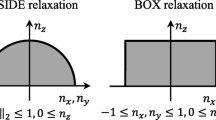Abstract
There are various segmentation and surfacing methods to create CAD models from measured data. First the difficulties of creating a good surface structure over a polygonal mesh are investigated, followed by investigating the most important approaches according to the amount of user interaction, computational efficiency and surface quality. References to commercial systems are also added. The focus of the paper is to present (i) automatic surfacing and (ii) functional decomposition. New demands and emerging technologies are also identified to trace out current trends in digital shape reconstruction.
Preview
Unable to display preview. Download preview PDF.
Similar content being viewed by others
References
Alias Studio Tools: http://www.alias.com
Attene, M., Falcidieno, B., Rossignac, J., Spagnuolo, M.: Edge-Sharpener: Recovering sharp features in triangulations of non-adaptively re-meshed surfaces. In: Kobbelt, L., Schröeder, P., Hoppe, H. (eds.) Eurographics Symposium on Geometry Processing. The Eurographics Association (2003)
Benkö, P., Martin, R.R., Várady, T.: Algorithms for Reverse Engineering Boundary Representation Models. Computer Aided Design 33, 839–851 (2001)
Benkö, P., Andor, L., Kós, G., Martin, R.R., Várady, T.: Constrained Fitting in Reverse Engineering. Computer Aided Geometric Design 19(1), 173–205 (2002)
Benkö, P., Várady, T.: Segmentation methods for smooth point regions of conventional engineering objects. Computer-Aided Design 36, 511–523 (2004)
Bernardini, F., Rushmeier, H.: The 3D Model Acquisition Pipeline. Computer Graphics Forum 21(3), 149–172 (2002)
Blacker, T.D., Stephenson, M.B.: Paving: A New Approach to Automated Quadrilateral Mesh Generation. International Journal for Numerical Methods in Engineering 32, 849–866
CopyCad: http://www.delcam.com
Eck, M., Hoppe, H.: Automatic reconstruction of B-spline surfaces of arbitrary topological type. In: Proc. Siggraph Computer Graphics, pp. 325–334 (1996)
Edelsbrunner, H., Facello, M.A., Fu, P., Qian, J., Nekhayev, D.V.: Wrapping 3D scanning data. In: Ellson, R.N., Nurrep, J.H. (eds.) Proc. SPIE, Three-Dimensional Image Capture and Applications, vol. 3313, pp. 148–158 (1998)
Edelsbrunner, H., Harer, J., Zomorodian, A.: Hierarchical Morse-Smale complexes for piecewise linear 2-manifolds. Discrete Comput. Geom. 30, 87–107 (2003)
Floater, M.S.: Parametrization and smooth approximation of surface triangulations. Computer Aided Geometric Design 14, 231–250 (1997)
Garland, M.: Multiresolution modeling: Survey and future opportunities. In: Eurographics 1999—State of the Art Reports, pp. 111–131 (1999)
Geomagic Studio: http://www.geomagic.com
Hoschek, J., Lasser, D.: Fundamentals of Computer Aided Geometric Design. A. K. Peters, Wellesley (1993)
ICEM Surf and RevEng: http://www.icem.com
ImageWare: http://www.ugs.com/products/nx/imageware
Itoh, T., Shimada, K.: Automatic Conversion of Triangular Meshes Into Quadrilateral Meshes with Directionality. International Journal of CAD/CAM 1, 11–21 (2002)
Kós, G., Martin, R.R., Várady, T.: Methods to recover constant radius rolling ball blends in reverse engineering. Computer Aided Geometric Design 17, 127–160 (2000)
Kós, G., Várady, T.: Parameterizing Complex Triangular Meshes. In: Lyche, T., Mazure, M.-L., Schumaker, L.L. (eds.) Curve and Surface Design, Saint-Malo, pp. 265–274. Nashboro Press (2002)
Krishnamurthy, V., Levoy, M.: Fitting smooth surfaces to dense polygonal meshes. In: Proc. Siggraph Computer Graphics, pp. 313–324 (1996)
Langbein, F.C., Marshall, A.D., Martin, R.R.: Choosing consistent constraints for beautification of reverse engineered geometric models. Computer-Aided Design 36, 261–278 (2004)
Lee, A., Sweldens, W., Schroeder, P., Cowsar, L., Dobkin, D.: MAPS: multiresolution adaptive parametrization of surfaces. In: Proc. SIGGRAPH Comput. Graphics, pp. 95–104 (1998)
Nakamoto, A.: Diagonal transformations in quadrangulations of surfaces. J. Graph Theory 21, 289–299 (1996)
Owen, S.J.: A Survey of Unstructured Mesh Generation Technology. In: Proceedings 7th International Meshing Roundtable, Dearborn, MI (October 1998), http://www.andrew.cmu.edu/user/sowen/survey/index.html
ParaForm: http://www.metris.com
Petitjean, S.: A survey of methods for recovering quadrics in triangle meshes. ACM Computing Surveys (2002)
PointMaster: http://www.knotenpunkt.com
PolyWorks: http://www.innovmetric.com
RapidForm: http://www.rapidform.com
Renner, G., Weiss, V.: Exact and approximate computation of B-spline curves on surfaces. Computer-Aided Design 36, 351–362 (2004)
Sabin, M.: Subdivision Surfaces. In: Farin, G., Hoschek, J., Kim, M.-S. (eds.) Handbook of Computer Aided Geometric Design, ch. 12, North-Holland, Amsterdam (2002)
Sederberg, T.W., Zheng, J., Bakenov, A., Nasri, A.H.: T-splines and T-NURCCs. ACM Transactions on Graphics 23, 477–484 (2003)
TEBIS: http://www.tebis.com
Várady, T., Martin, R.: Reverse Engineering. In: Farin, G., Hoschek, J., Kim, M.-S. (eds.) Handbook of Computer Aided Geometric Design, ch. 26, North-Holland, Amsterdam (2002)
Weiss, V., Andor, L., Renner, G., V’arady, T.: Advanced surface fitting techniques. Computer Aided Geometric Design 19(1), 19–42 (2002)
Werghi, N., Fisher, R., Robertson, C., Ashbrook, A.: Object reconstruction by incorporating geometric constraints in reverse engineering. Computer-Aided Design 31, 363–399 (1999)
Author information
Authors and Affiliations
Editor information
Editors and Affiliations
Rights and permissions
Copyright information
© 2005 Springer-Verlag Berlin Heidelberg
About this paper
Cite this paper
Várady, T., Facello, M.A. (2005). New Trends in Digital Shape Reconstruction. In: Martin, R., Bez, H., Sabin, M. (eds) Mathematics of Surfaces XI. Lecture Notes in Computer Science, vol 3604. Springer, Berlin, Heidelberg. https://doi.org/10.1007/11537908_24
Download citation
DOI: https://doi.org/10.1007/11537908_24
Publisher Name: Springer, Berlin, Heidelberg
Print ISBN: 978-3-540-28225-9
Online ISBN: 978-3-540-31835-4
eBook Packages: Computer ScienceComputer Science (R0)




